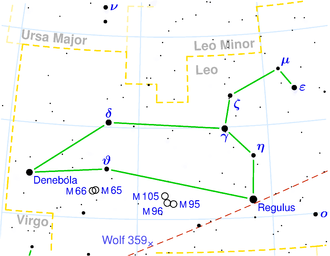NGC 3088
| Galaxie NGC 3088 | |
|---|---|
 | |
| SDSS-Aufnahme | |
| AladinLite | |
| Sternbild | Löwe |
| Position Äquinoktium: J2000.0, Epoche: J2000.0 | |
| Rektaszension | 10h 01m 19,2s[1] |
| Deklination | +22° 24′ 13″[1] |
| Erscheinungsbild | |
| Morphologischer Typ | S0 + S[1][2] |
| Helligkeit (visuell) | A: 13,8 mag B: 15,0 mag[2] |
| Helligkeit (B-Band) | A: 14,8 mag B: 15,8 mag[2] |
| Winkelausdehnung | A: 0,5' × 0,3' B: 0,5' × 0,1'[2] |
| Positionswinkel | A: 69° B: 135°[2] |
| Flächenhelligkeit | A+B: 11,6 mag/arcmin²[2] |
| Physikalische Daten | |
| Rotverschiebung | 0.025401[1] |
| Radialgeschwindigkeit | 7615 km/s[1] |
| Hubbledistanz vrad / H0 | (337 ± 23) · 106 Lj (103,3 ± 7,2) Mpc [1] |
| Geschichte | |
| Entdeckung | Wilhelm Herschel |
| Entdeckungsdatum | 12. März 1784 |
| Katalogbezeichnungen | |
| NGC 3088 • UGC 5384 • PGC 28997/28998 • CGCG 123-013 • MCG +04-24-010/011 • GC 1990 • H III 24 • h 661 • LDCE 0690 NED004 | |
NGC 3088 ist ein interagierendes Galaxienpaar im Sternbild Löwe am Nordsternhimmel. Es ist schätzungsweise 337 Millionen Lichtjahre von der Milchstraße entfernt.
Das Objekt wurde am 12. März 1784 von Wilhelm Herschel entdeckt.[3]
Weblinks
Einzelnachweise
Auf dieser Seite verwendete Medien
Autor/Urheber: Copyright © 2003 Torsten Bronger., Lizenz: CC BY-SA 3.0
This is a celestial map of the constellation Leo, the Lion.
Autor/Urheber: Sloan Digital Sky Survey, Lizenz: CC BY 4.0
The sky image is obtained by Sloan Digital Sky Survey, DR14 with SciServer.
Angle of view: 4' × 4' (0.3" per pixel), north is up.
Details on the image processing pipeline: https://www.sdss.org/dr14/imaging/jpg-images-on-skyserver/



